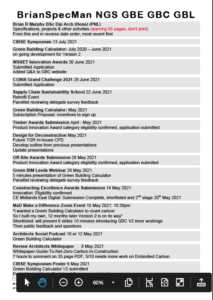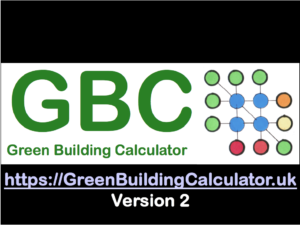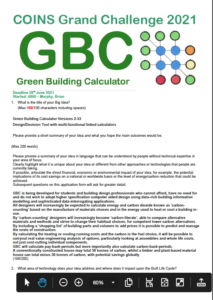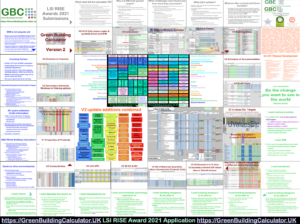
About:
COINS Grand Challenge 2021 Competition
Green Building Calculator
GBE Video
Submission: On-line form + CV + PDF file
Deadline: 28th June 2021
Submitted: 26th June 2021

Brian Murphy Project List Reverse 260621 Cover PNG
Additional File Powerpoint CPD PDF

GBC CPD Green Building Calculator COINS A06 BRM 260621.pdf
COINS Grand Challenge 2021 Q+A PDF
What is the title of your Big Idea?
Green Building Calculator Versions 2-33
Design/Decision Tool with multi-functional linked calculators
Please provide a short summary of your idea and what you hope the main outcomes would be.
- Please provide a summary of your idea in language that can be understood by people without technical expertise in your area of focus.
- Clearly highlight what it is unique about your idea or different from other approaches or technologies that people are currently taking.
- If possible, articulate the direct financial, economic or environmental impact of your idea, for example, the potential implications of its cost savings on a national or worldwide basis or the level of energy/carbon reduction that could be achieved.
- Subsequent questions on this application form will ask for greater detail.
- GBC is being developed for students and building design professionals who cannot afford, have no need for and do not wish to adopt higher specification computer aided design using data–rich building information modelling and sophisticated data-interrogating applications.
- All designers will increasingly be expected to calculate energy and carbon dioxide known as ‘carbon-counting’ based on the manufacture of materials chosen and in the energy used to heat or cool a building in-use.
- By ‘carbon-counting’ designers will increasingly become ‘carbon-literate’, able to compare alternative materials and methods and strive to change their habitual choices, for competent lower-carbon alternatives.
- By including a ‘shopping list’ of building parts and columns to add prices it is possible to predict and manage the costs of construction.
- By calculating the heating or cooling running costs and the carbon in the fuel choice, it will be possible to carryout real value engineering analysis of options, particularly looking at assemblies and whole life costs, not just cost-cutting individual components.
- GBC will calculate pay-back-periods but more importantly also calculate carbon-back-periods.
- A conventionally constructed house may total 50 tonnes of carbon, whilst a timber and plant-based material house can total minus 50 tonnes of carbon, with potential savings globally.
What area of technology does your idea address and where does it impact upon the Built Life Cycle?
- The Built Life Cycle is a way of looking at homes, buildings, factories, roads, railways and other parts of the built environment over their entire life cycle.
- Major stages of the Built Life Cycle include design, construction, operation, demolition and waste management.
- Please specify which stage of the Built Life Cycle your idea will affect, for example, during the design and operation of the built asset.
- If the idea relates to a sub-process of one or more of the major life cycle stages, please make the relationship clear.
GBC Version 2:
- A design and decision tool to help make better informed choices
- Addresses any building use, construction method, new-build and refurbishment
- Calculates full life cycle assessments
- Analyses many major stages of the built life cycle.
GBC Versions 3 to V33 calculators will address many other design issues, including:
- Avoiding surface and internal condensation
- Landscape
- Infrastructure
- Plastics reduction
- Healthy materials choice, reducing indoor pollution, avoiding overheating
- Interiors, furniture
- Circular economy: reclaim, reuse, recycled content, waste minimisation by design
- Energy services, lighting design and ‘light-nutrition’
- Nature surveys before and after monitoring net-gain
- Facilities management and specification ‘recipes’
- Design for durability
What is innovative about your Idea and what area of technology does it address?
- Clearly articulate in what way you consider your idea to be innovative, for example, is it innovative from a Technical point of view, Commercial one, or both?
- Is the idea completely new or does it adapt and make use of an existing technology/concept in a new way?
- If you believe the idea is completely new, please describe on what basis you believe that to be the case.
- If it adapts and makes use of existing technology and concepts, clearly state how you believe your use differs from the approach of others who may have been down this route before.
GBC Version 2
- Is a design and decision tool with building technology and materials guidance
- Its users create a numerical and text description or ‘model’ of a building or buildings, just once
- It carries out many calculations addressing many issues all based on data in that one ‘model’.
- What is new is that GBE does lots of interrelated calculations, all in one place, so that results of one calculation reacts with many other multi-functional calculators and gives instantaneous results to them all, to allow users to make well informed decisions easily.
- Uses familiar MS Excel functions including: drop down lists and look up tables, to auto-populate cells with appropriate competent materials, products, accessories and their data to carryout calculations
- GBC is open-book to allow users to observe, compare and learn as they acquire ‘carbon know-how’.
- Includes a MS Excel ‘shopping list’ bill of materials, products, accessories, labour and costs, which auto-totals up all items, avoiding risks of erroneous manual summing up
- GBC uses Life Cycle Assessment (LCA) data from published Environmental Product Declarations (EPD) in component, element and whole building calculations
- Enables value-engineering not cost-cutting to be carried out with little effort taking into account all ramifications of any decision
- Enables Specification Substitution to become a well informed process
GBC Version 3 & 4
- Will include a ‘recipe for building’ robust specification generator
- Since many low-carbon products may be new to users, ‘intelligent product data collection forms’ will steer users away from bad choice of products in wrong applications
What economic, social and environmental benefits do you expect your idea to deliver and over what timescale?
- This is your opportunity to demonstrate the benefits you believe your idea will deliver to an individual business, the construction industry or society in general.
- Consider the impact upon supply chain, end consumers and the wider society as well as direct financial benefits to the organisation developing or promoting the idea.
- Also outline any potential social impacts, such as improvements in the quality of life for construction workers or end consumers. Social impacts could also include better implementation of construction projects to improve social inclusion.
- You should also describe and quantify the environmental impacts of your idea where possible: for example, reducing fossil fuel emissions, protecting the climate, reducing water/ energy consumption, reducing materials waste, improving construction lifespan and including re-use and recyclability at end of life.
Building design and construction is a slow process and legislation that drives it is even slower to respond to the Climate & Biodiversity Emergencies:
- UK Government pledged in 2019 and publishing many ambitious policies but no improved or new Regulations
- Until recently the Construction Industry, Limited Companies in particular (under fiduciary rules, an obligation to maximise profits for shareholders) tended to work to regulated legal-minimum to maximum ‘profits before people before planet’; this appears to be changing, we hope that continues.
- Society, influenced by Extinction Rebellion (XR), David Attenborough’s nature documentaries and Greta Thunberg behaviour-change campaigns, are waking up and enabling change.
- London Energy Transformation Initiative (LETI) have produced guidance on in-use energy and carbon and embodied carbon (EC)
- Architects Climate Action Network (ACAN) are campaigning for stronger and appropriate legislation including promoting mass timber for its fire resistance and for absorbing carbon dioxide during growth ‘sequestered carbon’ (SC)
- Royal Institute of British Architects (RIBA) have published RIBA 2030 Climate Challenge, a voluntary but essential set of targets for its members to embrace in all future building designs
- Architects Declare, Education Declare and numerous other Declares are campaigning for more rapid change and better climate related education (evidence so far shows this is already patchy)
- A significant number of individuals and businesses have been proactive, not waiting for legislation but are acquiring new knowledge, skills and tools to address what they can, soonest.
- A much larger number of individuals and businesses will engage slowly and some reluctantly, they will need more help to join in.
GBE HERACEY™ represents our more readily understood definition of Sustainability:
- Healthy Environmental Resourceful Appropriate Competent Effective Yardstick
- Based on 400 technical, environmental, health and social criteria
GBC V2 intends to provide an interactive tool for everyday use in design and decision-making:
- GBC already includes LETI, ACAN, RIBA & other challenges and campaigns as optional targets for users to choose for their project calculations
- The calculator warns if targets are not being met and enables reviewing previous decisions and increasing insulation thicknesses for better performance and close the gap
- Meeting higher ambitious targets will reduce energy demand, carbon production or carbon release and increase carbon sequestration
- GBC must not become a means to record a previous bad decision and make no changes nor differences to the outcomes, which happens with popular Environmental Assessment Methods (EAM)
GBC V2 uses an Intelligent Product Data Collection (IPDC) form,
- GBC collects data from manufacturers and suppliers:
- What problem the product was solving when invented
- What is its primary function
- What is its primary material
- Where in the building elements it is to be used
- Product properties data for:
- Calculations
- Embodied Energy (EE), Embodied Carbon (EC) and Sequestered Carbon (SC)
- LCA & EPD
- Robust specifications
GBE V3 & V4 will introduce a filtering system:
- Using the IPDC collected data,
- Products will be filtered into groups
- To only offer competent products in any components of elements in any function and application
- In doing so it addresses one Post-Grenfell Hackett Report objective: part of a golden-thread of information about product application to help avoid incorrect use
- Uses drop down lists to choose product names from look up tables
- Interrogates look up tables to populate cells with chosen product data:
- To carryout calculations
- Assemble specification texts
Once Version 2 is launched GBC will start user and steering group meetings
- To ensure we priorities users needs and desires
- Organise Versions 3 – 33 into a user preferred order
- Catch anything that may have slipped through the net,
- e.g. preventing GBC becoming an ‘approved tool’
- Invite users to offer project datasets for GBC to collate
- To enable publishing ‘Carbon Saved in 2021-22 by GBC V2’ etc.
Supply chains need to change and start responding to new demands:
- Not to hope to continue to deliver solely what they have sold in the past
- To match the demand of the current objectives, campaigns and funding programmes
- Delivering low-energy, low-carbon, low-chemistry, low-irritant, healthy, low-water, solutions
- Learn about their positive properties and help promote their competent application
- Including planet-friendly and human-healthy materials and products to make, install, use, maintain, deconstruct, reuse and recycle
- Green suppliers will be approached to participate in product data collection
Clients need to get what they asked for:
- When they arrive with a brief for a green, healthy, appropriate building that fits their organisation
- Not what is left after our industry has value-engineered, cost-cut and substituted-out all the good stuff:
- Whilst chasing artificially low cost-plans and short-term false-economies
Client/Designer Priorities: V33
- Not previously considered here (prompted by COINS questionnaire, thank you)
- Consider screening to match priorities
- Consider which issues are to be addresses and how robustly
- Screening options: healthy, carbon, water, waste minimisation, circular economy: recycled content, reclaimed for reuse; plastic-avoidance, bio-based, durability, product quality, self-build, etc.
- Use IPDC collecting additions data points to enable screening appropriate materials and products
Green Building Encyclopaedia (GBE) website provide complimentary platforms:
- For GBC to links to for Jargon Busters, Checklists, design guidance, CPDs, Reference documents and websites, etc.
- To introduce problem-solving solutions that are not as easily visible in conventional databases
- Provide GBC with GBS Robust Specifications for products and materials
Green Building Learning (GBL) website provides a platform for promotion and dissemination of:
- GBE & GBL CPD seminars, webinars, workshops, visits and videos
- GBC introduction and instruction videos.
GBC is effectively a 4th career starting just before retirement and pension is thrust upon me.
- Will remain a stimulus to keep my brain busy and fully functional for as long as possible
- If it generates sufficient income it will enable the development of the 33 version planned so far
- To serve the GBC users and provide better tools and better more comprehensive datasets
- Enable enrichment of GBC, GBE and GBL websites and interlinking to serve each other
How would you intend to go about implementing your Idea?
- Describe what steps you would envisage having to take to achieve your idea.
- These should include such things as:
- The amount of potential funding required to commercialise your idea.
- What enhancements to your own skill set would you need and how you would go about addressing these requirements?
- This could be through further education or finding partners or sponsoring organisations, etc.
- What other non-financial support would be required?
Implementation:
- Understanding how each calculator interacts with the others is essential to avoid conflicts
- It is currently anticipated that only one person will continue to develop the calculators
- However Product Data Collection and its confirmation will be done in conjunction with manufacturers and suppliers
- GBC provides intelligent, colour-coded cells, self-explanatory, data collection template but will also provide video, webinar or face to face introductions on how it works and how to use it
- GBC has to check it has been used correctly before merging it into the Look-up-tables and drop-down-list
- Merging other datasets before adding to GBC can be carried out by sub-contractors but checked by GBC
Funding:
GBC V1 was launched July 2020 as a milestone issue
- 440 hours of development
- Costs for GBC download varied between £4.88 (students and low-carbon self-builders) and £98.88 (bigger practices) for a one-off payment
GBC V2 launch is imminent and will contain essential parts to generate greater interest by users
- 1115 additional hours of development (to June 2021)
- Cost of file downloads will probably change to annual subscription to enable continuing development
- It is hoped that sales will generate income to continue development of the 33 versions currently planned
- The scale of the sales will dictate the speed of development
GBC V3 to V33 (not yet prioritised with proposed user/steering groups)
- Assume 100-1500 hours development per version
- V3 Decrement Delay, Form Factor refinements: dormers, bays, porches (Started in V2)
- V4 Building Section Coding, Competent Application,
- 892 ready made elements, Bespoke Assemblies, Accessories, Specification Generator
- V5 Non-Domestic, Retrofit and New-build, more refinements
- V6 Embodied Energy, Carbon and Sequestered carbon; Non-external envelope elements (V2 started)
- V7 Condensation Check, Thermal Bridge, Secondary Element Calculator, Thermal mass calculator
- V8 LCA Calculator (Started in V2)
- V9 Landscape (Started in V2)
- V10 Civil Engineering and Infrastructure: scope increase (Started in V2)
- V11 Waste Calculator Using existing WasteCost®Lite calculator functions
- V12 Plastic-free v Recycled Plastic
- V13 Interiors: Scope increased, Ska fit-out. refit
- V14 Circular economy: Reclaim, Reuse and Specification clauses
- V15 Self-build Interface with GBE & GBL
- V16 Develop Computer Aided Design, Building Information Modeling Application to populate calculator cells automatically
- V17 Whole Project Budget Calculations, full Fee bid calculation based on cost-plan
- V18 EU and International versions
- V19 Services Design Module: Occupancy level, Energy Sources and uses,
- V20 Lighting Design Module: Health & Wellbeing, Light Nutrition
- V21 Biodiversity Inclusion, Biodiversity Net Gain
- V22 Local Climate Appropriate construction and materials
- V23 Vernacular, local: materials, trades, economy
- V24 Green Building Price Book (GBPB) (prioritise)
- V25 Operation & Maintenance Manuals (O&MM) and Specification
- V26 Facilities Management (FM) and Specification
- V27 Local Procurement, Transport to site, distance search facility
- V28 On Site Construction Emissions for LCA and EPD
- V29 Design Life, Durability and Competent materials
- V30 Air tightness & Energy Loss (prioritise)
- V31 Value Engineering Opportunities: adding in rather than cutting out
- V32 Healthy Building
- V33 Screening Priorities
B Bespoke development with sponsoring clients
- B1 Retrofit Historic fabric Window & Insulation Calculator (Commission started June 2021)
- B2 Screeds Calculator (Commission proposed June 2021)
- B3 Window U, G and Psi Calculator (Started in V2)
Skills: (45 year old College-Knowledge needs refreshing)
- I will address the development of skill-sets for each Version:
- Examples:
- Condensation
- Decrement Delay
- Psi values
- G values
- Thermal mass
- TGR, AECB, PHT, GHA, STBA, TRA, etc. run suitable training webinars that I will attend
- Or I will contact the speakers for expert guidance or sub-consultancy
- I already have a mathematics graduate who checks my Excel equations
- Obtain publications/standards on the subject to get up to speed
Costs: (Wish-list: Guesstimates)
- Version development: 100-1500 hours = 33 No. x average 500 hr x £25 = £412,500.00 (8-11 years)
- Develop CAD BIM App and Dashboard: £20,000 + Updates
- PowerPoint CPD file exists (will continue to be updated)
- Can be printed for exhibition displays (£250 + update prints)
- Display frame: Exists
- Could consider a new cardboard display: £2,000
- Poster Exists in PowerPoint file (can be updated) (Printing: £100)
- Exhibition Attendance: 3x3m £5,000/event, 3-10 events/annum £15,000-£50,000/annum
- Exhibition hardware: Large touch-screen monitor, Short-throw projector, 3x3m Projection screen, £5,000 once
- Logo: Designed
- Embroidered Logo Template: £200
- Liveried Uniform: Shirt, sweat shirt, jacket, cap, facemask, £200/person
- Business Cards: Design: £50, Print: £200/event
- Post card: Design: £100, Print: £50/event, 110/annum, £22,000/annum
- Visits to do CPD: Travel: Average £100/visit, 100/annum, £10,000/annum
- Travel to Exhibitions with display: vehicle hire & Fuel average: £150, 3-10/annum £450-£1,500
- Mailchimp account exists £39/month £468/annum
- Mailing lists: exists but could be consolidated
- Zoom Pro account exists £16/month £256/annum
What are the risks in relation to your idea?
- Outline any risks associated with your idea.
- These should include technical, financial, social and environmental.
- You should also state how you believe any identified risks could be mitigated.
One person (65 years old),
- Only one person developing GBC at the moment
- Risk of dementia or death preventing completion
- Possible solution: write an aide-memoir or detailed specification about planned versions describing anticipated development, inner workings and interactions for another to complete
Many carbon tools have appeared in the market recently
- Some are one issue ‘Top-Trumps’ LCA or carbon only:
- One click LCA is probably too simplistic and very LCA Specific
- ICE Structural carbon calculator: too simplistic for whole buildings,
- Requires 100s of hours by users to do building assessment
- Users will be tempted to do less work than is needed
- GBC is multi-functional calculator addressing many issues at the same time:
- Focussed on building performance and competence first
- EE, EC, SC, LCA and EPD are also calculated
GBC V2 sets out to carryout accurate calculations that reflect the designer’s intentions
- Exiting Environmental Assessment Methods (EAM) including BRE EAM
- Cites use of Green Guide to Specification (GGtS)
- Readymade Elemental Assemblies with Generic materials only
- Interpolation not permitted for bespoke assemblies
- Users submit a bespoke assembly to BRE to do an assessment, delaying completion
- GBC V2 starts with bespoke assemblies and V3 & V4 will provide readymade assemblies and manufacturer certified assemblies
- In order to become a ‘approved tool’ under various schemes, GBC may be expected to compromise and follow their approaches (yet to be determined).
GBC V2 will be sold on a subscription service to fund updating of datasets and adding more functionality
- Mailchimp Email campaign to existing users
GBC V2 to V33 will continue to add functionality
- Insufficient subscriptions may not afford the time to develop the versions quickly enough
- May deliver this tool after the necessity arose for designers to engage in other calculations
What skills and experience do you have or need for your Idea to succeed?
- List the key skills and experiences that you believe would be required for your idea to succeed.
- Where you believe that you possess the right skills and experience, you should give examples of how you have developed and used them in your career to date.
- If you have identified areas for further development, you should explain how you would go about acquiring those skills in the future.
- The Judges will be looking for people to demonstrate that they understand what personal skills or experiences are required to succeed with their chosen idea; that they have the self-awareness and confidence to overcome any skills shortages through personal development; or that they are able to attract, engage and manage others that may possess the required skills.
48 years in Construction industry.
- First 10 years in small firms, wide range of new and existing buildings, getting a thorough grounding in building technology and communicating
- 4 years studying day release ONC & HNC Construction.
- Worked with talented Architects whilst studying 7 years BSc Degree and PG Diploma in Architecture,
- Solid background giving freedom to ‘fly kites’ unrestricted by lack of construction know-how.
- Top-10 student, commended at BSc and Distinction with Honours at Diploma.
- Technical background lead back to the ‘nuts and bolts’ of building design process, specification consultancy for 37 years
- Successful commissions include, new build, alteration, extension, conservation quality refurbishment; public, private and speculative projects:
- Procured by general contracting, construction management, management contracting, design & build, etc.
- Project values: £50,000 to £511m. Package values: £10,000 to £12m. Total: £2,415m
- Clients include: architects, interior designers, furniture designers, landscape architects, facilities managers, manufacturers and suppliers, contractor at Group level.
- 22 years returning knowledge to professions via CPD (continuing professional development) seminars, conferences, practice’s staff development, workshops, specification, software training and individual tutoring
- >1000 hours of CPD seminars: specification, professional practice, and environmental construction
- Created 1000s of Robust Specification Clauses for projects to resist specification substitution
- 22 years Environmentalist by action, 1999 made public declaration of intent to work with designers adopting sustainable approaches to building.
- 2001 set out to create National Green Specification, http://GreenSpec.co.uk describing all products with the right environmental credentials and performance characteristics, available in or from the UK
- 2 years of UK research on waste minimisation and recycled content building materials with BRE,
- Created waste minimisation specification ‘chapters’ for demolition, alteration, excavation, new build and landscape
- Assembled spreadsheet of recycled building Products to populate 450 product pages with specifications
- Wrote 35 hours of CPD seminars on waste minimisation by design and recycled content
- Created WasteCost®Lite calculator to demonstrate how waste segregation could save 10 times the expenditure
- Created Environmental Building Checklist for use in projects and on website
- Created 892 low energy demand ‘Passivhaus’, ‘wall, floor, roofs’, etc. assemblies in MS Excel, including specification notes
- 1 of 3 man team created GreenSpecStudio an online interactive tool to assemble a text-only building in a day and it created a specification
- 10 years Lecturer and Studio Tutor at 10 Universities
- >9000 term jargon buster to help understand environmental construction
- 2011 Converted ICE Inventory of Energy and Carbon version 1.6 into a calculator, bringing windows, materials and insulation into a single spreadsheet to allow calculations
- Wrote & illustrate 50% of accommodating bats and birds RIBA book
- 5 year €8m Interreg-Funded CAP’EM project on LCA
- Developed CAP’EM Compass interactive tool to choose products to suit applications and get a Product Data Sheet with site-specific EPC ‘Impact assessment’
- Created Whole Building Calculators (WBC):
- In-use energy and carbon (in heating and cooling)
- Embodied energy and carbon (in the materials)
- 2012-2015 created and launched https://GreenBuildingEncyclopaedia.uk.
- 2020 launched Green Building Calculator V1 on https://GreenBuildingCalculator.uk
- Merged WBC to create Green Building Calculator Version 2
Weakness:
- Mechanical electrical services: Find specialist to help develop GBC V19-20
How do you think that winning this competition will help you to realise your Idea?
- Please state what you hope to get out of the competition and how it will take you closer to realising your idea.
Winning the competition:
- A personal pleasure to receive it
- A confirmation, that this is a good idea, by others, not just me; encouragement to continue
- A marketing opportunity to help in the promotion of GBC V2 to V33 to the construction sector, potential users, subscribers and data providers or processing and commissioning partners
Winning competition prize money: (wish-list)
- Can ensure GBC can commit to full time development for longer, if not until completion of V3-V33
- Help cash-flow to complete sooner
- Collect and confirm many more product and material Technical, EE, EC, SC, LCA & EPD datasets
- Think about and plan other version development
- Afford to exhibit (3-10 per annum)
- FutureBuild, UKConstructionWeek/Grand Design and regional Build and topical exhibitions
- Potential to speak at exhibitions
- Invite existing and potential users to GBC Next Version events on stand
- Hold an after-delegates leave, green manufacturer and supplier GBC IPDC presentation
- Have display at Swindon Self-build exhibition centre
- Updating displays, introduction and instruction videos and PowerPoint files for each Version
- Consider attending EU build exhibitions
- Build more links to GBC, GBE and GBL website content to expand learning opportunities
- Build Video/Audio channels and populate
- Focus on video files: promotions, announcements, instructions
- Update websites and social media with latest activity
- Restart mailchimp campaigns
- Offer to run free CPD at professional institute local chapter events, across the UK to increase potential subscriber awareness (50-100 events/annum)
- Update existing users (4-12 newsletters/annum)
© GBE GBC GBL NGS ASWS Brian Murphy aka BrianSpecMan **
26th June 2021 – 5th July 2021
Images:
Award & Exhibition Posters


Competition Body
Competition Scheme
COINS and UKCW 2021
Supporting Evidence
© GBE GBC GBL NGS ASWS Brian Murphy aka BrianSpecMan **
26th June 2021
See Also:
GBE Competitions
- COINS & UKCW 2021 (Competition) G#39804 (this page)
GBE Calculators
- GBC Green Building Calculator (Navigation) G#38828
GBE Satellites
GBE & GBC Awards
- 33 Awards up to September 2021
- 2 Submitted and Pending June 2021
GBE Accolades
- 100 Innovative Days G#14989
CAPEM Awards
- CAP’EM Investment Building Huddersfield Station Water Tower National Railway Heritage Award G#1311 N#1301
GreenSpec Awards
- BrianSpecMan founded GreenSpec before starting GBE
- GreenSpec Accolades (Award) G#681 N#703
© GBE GBC GBL NGS ASWS Brian Murphy aka BrianSpecMan **
26th June 2021 – 3rd September 2021

